Live-Webcams
Swinoujscie
Beach
on-line | Panorama
of the beach
On
the Polish side of the island of Usedom (Polish:
Uznam) is Swinoujscie pronounced
Shvin-o-oo-y-sh-che (German: Swinemunde), a
county and an important port established in 1740
by Emperor
Frederick the Great. Swinoujscie is also called Land of
44 Islands because Swinoujscie County is an
archipelago comprised of 44 islands. It's also
one of the most important counties in the Szczecin (Stettin) metropolitan
region and the West
Pomeranian Voivodeship. Swinoujscie is also the most
densely populated part of the island of Usedom.
"The town was first chronicled in 1181,
though it existed earlier as a fishing
settlement" - Enc.
Britannica.
The name of the town may be a difficult one for
many foreigners to pronounce. Hence, it's often
refered to by its former Pomeranian name
"Swinemunde", which was derived from
the Slavic name of the Swina
River. So,
both Swinoujcie or Swinemunde would translate
into English as SwineMouth or HogsMouth as in for
example Portsmouth or Plymouth.
Archaeological evidence from the island, which
can be found in a museum in Swinoujscie shows that the island had
been inhabited by man since Stone
Age, at
least for 5000 years. Swinoujscie has one of the
oldest known ferry
crossings,
which was first mentioned in a document in 1230
AD, making it the oldest still functioning ferry
crossings in the world.
Swinoujscie was also an important military port
during the two world wars. It was a location of
Prussian harbor commander, and German harbor
commander (Hafenkommandant) until the end of
WWII. The town was bombed once on March 12, 1945 by
USAF largely due to a Russian and/or British
intelligence mistake. On October 6, 1945 the town
was placed under Polish control through President
Franklin D. Roosevelt's last minute initiative. After the
fall of the Iron Curtain, the governments of
Germany and Poland affirmed the former agreement in
1990. Today, Swinoujscie is a dynamically
developing world class seaside resort.
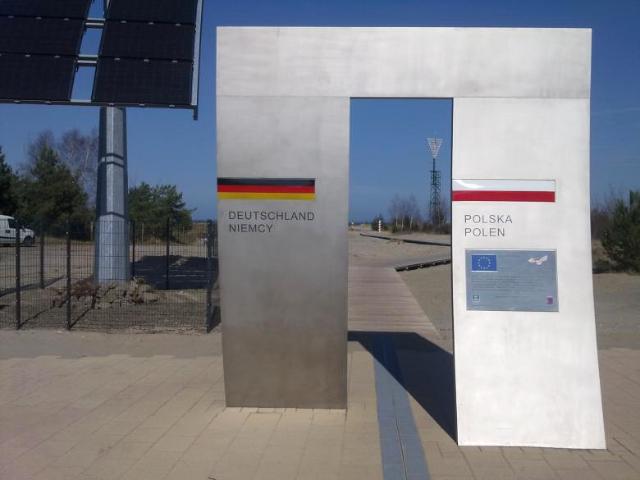 Monument on the German-Polish boarder. A boardwalk to the beach in the background.
See it @ Google Street View
Monument on the German-Polish boarder. A boardwalk to the beach in the background.
See it @ Google Street View
Swinoujscie was already a popular
resort among many international aristocrats and bourgeoisie; especially during the
industrial era. Emperor
Wilhelm II
visited Swinoujscie very often, and also met with
his cousin, the Tzar of
Russia Nicholas II there. Swinoujscie is also where Emperor
Wilhelm I
had a love affair, and where his first
illegitimate son was born [read
more]. Swinoujscie was where
many artists such as Marlene
Dietrich, Mata
Hari, Lyonel
Feininger
and Wojciech
Kossak
spent their summer vacations. It was a place
where one could meet in an informal way top
Central European leaders and celebrities of the
early 19th and 20th century, and a place where
many important business deals were made.
Lyonel
Feininger
(1871-1956), a leading New York expressionist painter spent summer
vacations on the island of Usedom between 1909
and 1921 when he was an art student in Berlin. He
was greatly inspired by the island and created
many painting and drawings there and continued
painting scenes from the island for the rest of
his artistic life, after returning back home to
the United States. A fifty kilometers long Lyonel
Feininger bike tour was created on the island
with signs on posts and round markers on the
ground to locations that were immortalized in
many of his works. Many of those are found along
the Feininger-Tour rout in Swinoujscie.
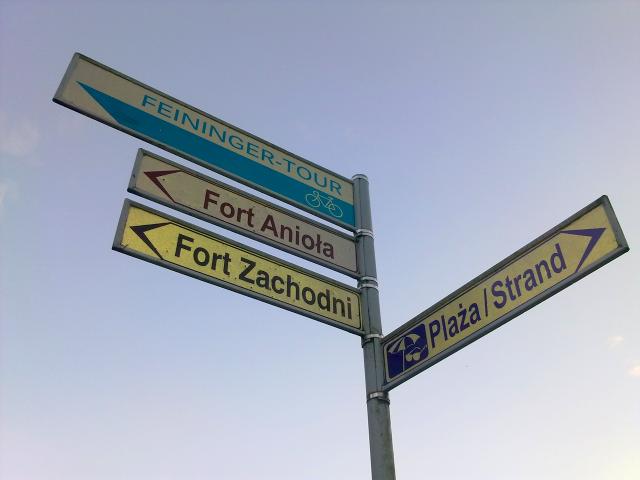
Swinoujscie's
pre-war nickname was "Bathtub of
Berlin" (Berlin aka Sin City). and
that says a lot about the town's guests and
freedom oriented culture in those days. Since
1824 when underground sources of high quality
brine and mud were discovered in Swinemunde and
used in the local spas, the town became a leading
19th century world class seaside spa resort. It
was especially popular through the Roaring
Twenties
until the end of WWII. After WWII, the town
continued to be a popular resort behind the Iron
Curtain.
Swinoujscie is also associated with Teodor
Fontane;
an important 19th-century liberal German writer.
Fontane spent part of his childhood in Swinemunde
after his family fell into some disrepair due to
his Father's gambling depths. Today, there is a
small makeshift museum in the town's center
dedicated to Fontane on the site where Fontane's
family home and his father's pharmacy once stood.
Swinoujscie is also where Baroness
Elsa von Freytag-Loringhoven was born. For those who
may not know the Baroness, she was an important
American Dadaist artist and poet that
worked and lived in New York's historic Greenwich
Village.
The Baroness held art exhibits in many fine
galleries and high places including The White
House. In a way, perhaps she embodies well the
town's former free and bohemian type spirit that drew
artists and forward thinkin people to its shores
until the mid 1940s.
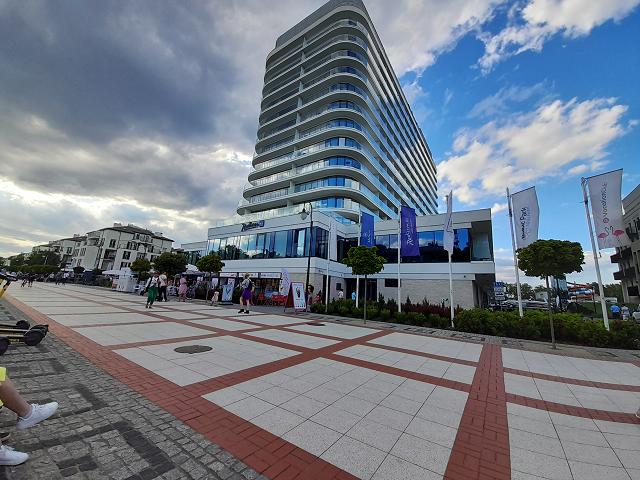 Baltic Park Molo and Radisson Blu Swinoujscie
Baltic Park Molo and Radisson Blu Swinoujscie
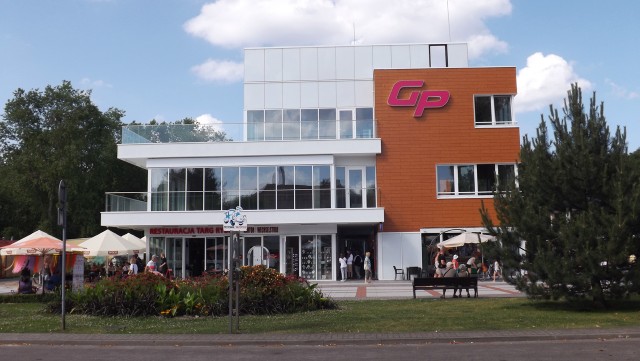 Galeria Promenada on the seaside promenade
Galeria Promenada on the seaside promenade
Swinoujscie has two promenades. The
first is on the Baltic Sea coast and the second
is on the Swina River. Compared to neighboring
German towns on the other side of the island,
Swinoujscie has a more urban type of character
and is becoming the island's leading shopping and
business center. There are many shopping malls,
leading European supermarkets, international
hotels, fast foods such as McDonald's, a 3D
Cinema by Corso and many other conveniences.
Therefore, one can go shopping in Swinoujscie all
year-round while enjoying the four seasons and
the elements on the island's pristine sandy
beaches and Eco zones.
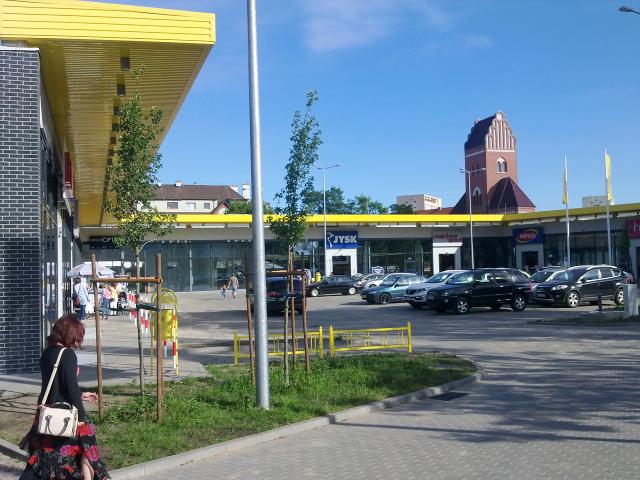 Stop Shop shopping market
Stop Shop shopping market
 CORSO Shopping Center & Cinema
CORSO Shopping Center & Cinema
 CORSO Shopping Center & Cinema
CORSO Shopping Center & Cinema
 Leading grocery supermarkets
Leading grocery supermarkets
Swinoujscie is also a busy transit
center for regular passenger connections with Ystad and Trelleborg in Sweden, Denmark,
Germany and historic island of Wolin. It's also near the island
of Rugen were the historic Cape
Arkona is
located. Plans are also underway to restore an
old railroad connection through the Karnin
Lift Bridge,
which would shorten travel time between Berlin
and the island to about two hours, and other
plans to make new and shorter road connections
with Szczecin (Stettin) in Poland.
Swinoujscie has the best
cycling routs in Europe that stretch along the
Baltic Sea coast of Germany and Poland. Long
distance routs go as far as Hamburg, Berlin,
Sopot, Gdansk, Gdynia, the island of Rugen and
also Sweden and Denmark via over-night ferries.
Shorter routs are around Usedom island, Wolin
Island, Szczecin
Lagoon and
through various popular resort towns, historic
sites, a Viking
village on
the island of Wolin, luscious wilderness and many
other attractions.

Swinoujscie
is the fourth and most important imperial resort
(Kaiserbader) on the island. On the neighboring
island of Wolin is Miedzyzdroje (German: Misdroy), which
is another popular former imperial resort located
in Poland. It's very easy to commute between the
two resorts by city bus that runs between
Swinoujscie's Warszowa neighborhood on the island
of Wolin and Miedzyzdroje (Misdroy). The bus stop
to Miedzyzdroje is directly across the street
from the Polish train station, which is perfectly
located across the street from the ferry
crossing.
There are also regular bus connections to Szczecin (Stettin) and the
"Solidarity" Szczecin-Goleniow Airport.
Seasonal air connections to the island are also
available with some German, Polish and Swiss
cities at the Heringsdorf
Airport (info
in
Polish) located near Garz, Germany.
So, we are looking forward to seeing you in
Swinoujscie and on the sunny island of Usedom
soon. Wishing you smooth sailing...
|